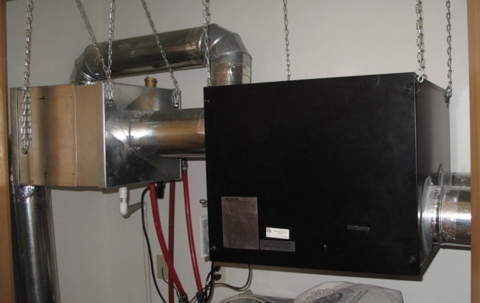Maintaining a healthy and comfortable indoor environment is essential for the well-being of the occupants of your home. With energy-efficient home design and an increased focus on air-tight sealing, proper ventilation is crucial to prevent air stagnation and ensure optimum indoor air quality. Heat recovery ventilators (HRVs) and energy recovery ventilators (ERVs) are innovative solutions that can simultaneously improve air quality and energy efficiency in residential spaces.
Understanding Heat Recovery Ventilators (HRVs)
Heat Recovery Ventilators (HRVs) are advanced mechanical systems designed to provide controlled ventilation while minimizing energy loss. HRVs work by transferring heat between the exhaust air from inside the home and the fresh air being drawn in from outside. This exchange occurs through a heat exchanger built within the ventilator.
By recovering heat from the stale air exiting your home, HRVs significantly reduce the energy required to heat the incoming fresh air. This innovative technology results in a more energy-efficient and cost-effective way of maintaining optimal indoor air quality.
Exploring Energy Recovery Ventilators (ERVs)
Like HRVs, Energy Recovery Ventilators (ERVs) are designed to improve indoor air quality and HVAC system efficiency. However, the primary difference between the two systems is that ERVs also transfer moisture between the incoming fresh air and the outgoing stale air. This feature makes ERVs particularly useful in areas where humidity control is essential for maintaining optimal indoor comfort.
In addition to transferring heat energy, ERVs transfer humidity between the exhaust and incoming air streams. This humidity exchange can be beneficial in both hot and cold climates. In hot, humid environments, ERVs reduce the moisture content of incoming air, reducing the need for air conditioning. In colder climates, ERVs help maintain adequate humidity levels indoors, preventing dry and stuffy conditions.
Benefits of HRVs and ERVs
Installing an HRV or ERV system can offer multiple advantages for homeowners, including:
- Improved Indoor Air Quality: Both HRVs and ERVs provide constant, controlled ventilation in your home, ensuring that fresh, clean outdoor air is continuously circulated throughout the space while removing stale, contaminated air. This continuous air exchange helps to control indoor pollutants such as allergens, dust, and volatile organic compounds (VOCs), contributing to better indoor air quality and overall health.
- Increased Energy Efficiency: HRVs and ERVs help to preserve much of the energy used to heat or cool your home by transferring heat and, in the case of ERVs, humidity between exhaust air and incoming fresh air. This heat and humidity transfer reduces the energy demanded by your HVAC system, ultimately resulting in lower energy bills and a reduced environmental impact.
- Reduced Condensation: By facilitating proper humidity control, ERVs can help reduce condensation on windows and other surfaces, preventing mold growth and structural damage caused by excess moisture.
- Enhanced Indoor Comfort: Both HRVs and ERVs help to maintain a comfortable and well-balanced indoor environment by supplying fresh, filtered air while preventing excessive temperature fluctuations and humidity disparities.
Choosing Between an HRV and an ERV
When considering whether to invest in an HRV or ERV system, you should always take into account factors such as regional climate and specific household needs:
- Climate: In colder, drier climates, HRVs are typically the preferred choice due to their superior heat transfer capabilities. Conversely, ERVs are more suitable for hot, humid climates or homes requiring moisture control.
- Humidity Control: If managing indoor humidity levels is a priority, ERVs can offer the added benefit of transferring moisture between exhaust and incoming air. This feature helps regulate humidity levels indoors.
- Building Design and Airtightness: HRVs and ERVs are particularly advantageous for well-sealed, energy-efficient homes where controlled ventilation is crucial. In older homes, additional sealing and insulation measures may be necessary to reap the full benefits of an HRV or ERV system.
Proper Maintenance for HRVs and ERVs
Ensure the optimal performance and longevity of your HRV or ERV system, and adhere to proper maintenance practices:
- Regular Filter Cleaning or Replacement: Clean or replace filters as recommended by the manufacturer to maintain efficient airflow and prevent strain on the system.
- Heat Exchanger Maintenance: Ensure that the heat exchanger core is clean and free of debris. Inspect and clean the heat exchanger as per the manufacturer’s instructions.
- Condensate Drain Inspection: Regularly inspect the condensate drainage system to ensure proper function and cleanliness.
Breathe Easy with Wolcott Services’ HVAC Expertise
Heat and energy recovery ventilators offer an innovative solution for maintaining comfortable and healthy indoor air quality while improving the energy efficiency of your home. By understanding the benefits, differences, and essential maintenance practices associated with these systems, you can make an informed decision on the right ventilation solution for your home.
We at Wolcott Services, a trusted provider of plumbing, electrical, heating, and cooling services in Portland, OR, are committed to helping you optimize your home’s overall comfort and energy efficiency. Our team of skilled professionals can assess your unique needs, recommend the most suitable HRV or ERV system, and provide expert heating installation and maintenance services. today to ensure that your home is well-ventilated, energy-efficient, and a comfortable haven for you and your family!
The post Heat and Energy Recovery Ventilators: Optimizing Indoor Air Quality and Efficiency appeared first on Wolcott Services.

